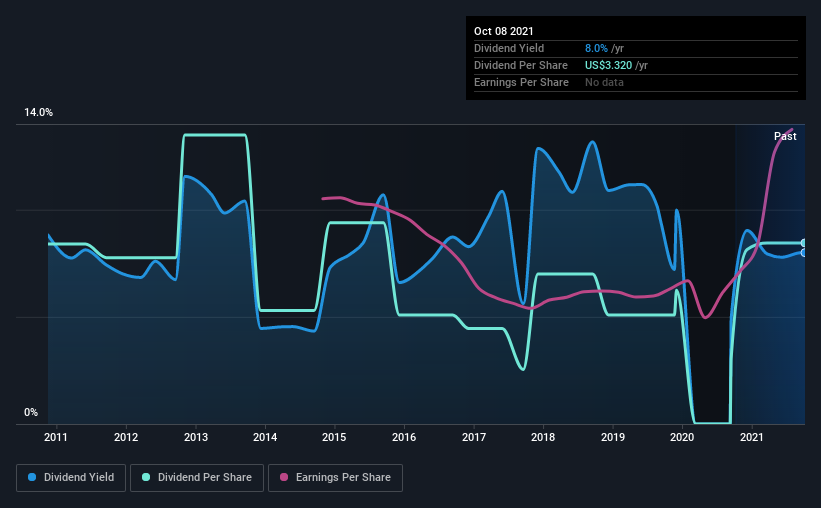There's A Lot To Like About Buckle's (NYSE:BKE) Upcoming US$0.33 Dividend
Regular readers will know that we love our dividends at Simply Wall St, which is why it's exciting to see The Buckle, Inc. (NYSE:BKE) is about to trade ex-dividend in the next four days. The ex-dividend date is usually set to be one business day before the record date which is the cut-off date on which you must be present on the company's books as a shareholder in order to receive the dividend. The ex-dividend date is important as the process of settlement involves two full business days. So if you miss that date, you would not show up on the company's books on the record date. Therefore, if you purchase Buckle's shares on or after the 14th of October, you won't be eligible to receive the dividend, when it is paid on the 29th of October.
The company's next dividend payment will be US$0.33 per share, and in the last 12 months, the company paid a total of US$3.32 per share. Based on the last year's worth of payments, Buckle has a trailing yield of 8.0% on the current stock price of $41.52. Dividends are an important source of income to many shareholders, but the health of the business is crucial to maintaining those dividends. So we need to check whether the dividend payments are covered, and if earnings are growing.
See our latest analysis for Buckle
If a company pays out more in dividends than it earned, then the dividend might become unsustainable - hardly an ideal situation. Buckle paid out a comfortable 29% of its profit last year. That said, even highly profitable companies sometimes might not generate enough cash to pay the dividend, which is why we should always check if the dividend is covered by cash flow. It paid out 21% of its free cash flow as dividends last year, which is conservatively low.
It's encouraging to see that the dividend is covered by both profit and cash flow. This generally suggests the dividend is sustainable, as long as earnings don't drop precipitously.
Click here to see the company's payout ratio, plus analyst estimates of its future dividends.
Have Earnings And Dividends Been Growing?
Stocks in companies that generate sustainable earnings growth often make the best dividend prospects, as it is easier to lift the dividend when earnings are rising. If business enters a downturn and the dividend is cut, the company could see its value fall precipitously. With that in mind, we're encouraged by the steady growth at Buckle, with earnings per share up 7.6% on average over the last five years. The company is retaining more than half of its earnings within the business, and it has been growing earnings at a decent rate. Organisations that reinvest heavily in themselves typically get stronger over time, which can bring attractive benefits such as stronger earnings and dividends.
The main way most investors will assess a company's dividend prospects is by checking the historical rate of dividend growth. It looks like the Buckle dividends are largely the same as they were 10 years ago.
Final Takeaway
From a dividend perspective, should investors buy or avoid Buckle? Earnings per share have been growing moderately, and Buckle is paying out less than half its earnings and cash flow as dividends, which is an attractive combination as it suggests the company is investing in growth. We would prefer to see earnings growing faster, but the best dividend stocks over the long term typically combine significant earnings per share growth with a low payout ratio, and Buckle is halfway there. Buckle looks solid on this analysis overall, and we'd definitely consider investigating it more closely.
On that note, you'll want to research what risks Buckle is facing. We've identified 3 warning signs with Buckle (at least 1 which is a bit unpleasant), and understanding these should be part of your investment process.
If you're in the market for dividend stocks, we recommend checking our list of top dividend stocks with a greater than 2% yield and an upcoming dividend.
This article by Simply Wall St is general in nature. We provide commentary based on historical data and analyst forecasts only using an unbiased methodology and our articles are not intended to be financial advice. It does not constitute a recommendation to buy or sell any stock, and does not take account of your objectives, or your financial situation. We aim to bring you long-term focused analysis driven by fundamental data. Note that our analysis may not factor in the latest price-sensitive company announcements or qualitative material. Simply Wall St has no position in any stocks mentioned.
Have feedback on this article? Concerned about the content? Get in touch with us directly. Alternatively, email editorial-team (at) simplywallst.com.

 Yahoo Finance
Yahoo Finance 
